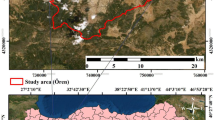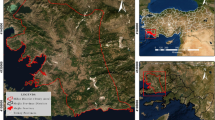Abstract
Lightning-caused forest fires can cause serious damage to the social economy and public property and even threaten human life. Therefore, lightning-caused forest fire risk rating assessment is very important for forest management agency, because the risk rating assessment results could provide important information to prevent fires and allocate extinguishing resources. The existing forest fire risk rating assessment methods are more difficult for the area with sparse meteorological stations, imperfect lightning monitoring systems and complex terrain conditions. Based on remote sensing data and case-based reasoning principle, this paper proposed a method to overcome the limitations of existing forest fire risk rating assessment methods. The proposed method uses three dynamic and two static indexes to characterize the potential fire environment. The dynamic indexes are temperature condition index, vegetation condition index and water condition index. The static indexes are terrain fluctuation and LIS/OTD lightning density. In DaXingAn Mountains of China, the fire risk rating spatial distribution maps with 8-day cycle before the occurrences of historical lightning-caused fires were produced by using the lightning-caused forest fire risk rating assessment method during 2000–2006 in this paper. The results showed that most of the historical lightning-caused fires occurred in the region with high fire risk rating, and the spatial–temporal distribution changes of the lightning-caused fire risk rating followed the same trend as the changes in the number of lightning-caused fires. Therefore, the lightning-caused forest fire risk rating assessment method proposed in this paper could assess the fire risk rating effectively, and this method could also provide a reference for other countries and regions with sparse meteorological stations and imperfect lightning monitoring systems.





Similar content being viewed by others
References
Ceccato P, Flasse S, Tarantola S et al (2001) Detecting vegetation leaf water content using reflectance in the optical domain. Remote Sens Environ 77(1):22–33
Chowdhury EH, Hassan QK (2015) Operational perspective of remote sensing-based forest fire danger forecasting systems. ISPRS J Photogr Remote Sens 104:224–236
Chuvieco E (ed) (2008) Satellite observation of biomass burning: implications in global change research. In: Earth observation of global change. Springer, New York, pp 109–142
Chuvieco E, Aguado I, Yebra M et al (2010) Development of a framework for fire risk assessment using remote sensing and geographic information system technologies. Ecol Model 221(1):46–58
Du YY, Zhou CH, Su FZ et al (2003) A model of geo-case based reasoning. Pattern Recognit Artif Intell 16(1):91–96 (in Chinese)
Du X, Zhou Y, Wang SX et al (2004) Monitoring and spatio-temporal evolution researching on vegetation leaf water in China. In: IEEE international geoscience and remote sensing symposium proceedings: science for society: exploring and managing a changing planet. IGARSS, pp 4273–4276
Feng Q, Tian GL, Wang AS et al (2004) Experimental study on the RS-based drought monitoring in China by using the vegetation condition indexes (II)-models of RS-based drought monitoring and the analyzed results. Arid Land Geogr 27(4):477–484 (in Chinese)
Gonzalez-alonso F, Cuevas JM, Casanova JL et al (1997) A forest fire risk assessment using NOAA AVHRR images in the Valencia area, eastern Spain. Int J Remote Sens 18(10):2201–2207
Gower JC (1971) A general coefficient of similarity and some of its properties. Biometrics 27:857–871
Guo FT, Hu HQ, Ma ZH et al (2010) Applicability of different models in simulating the relationships between forest fire occurrence and weather factors in Daxing’an Mountains. Chin J Appl Ecol 21(1):159–164 (in Chinese)
Han KS, Viau AA, Anctil F (2003) High-resolution forest fire weather index computations using satellite remote sensing. Can J For Res 33:1134–1143
Hernandez-Leal PA, Arbelo M, Gonzalez-Calvo A (2006) Fire risk assessment using satellite data. Adv Space Res 37(4):741–746
Illera P, Fernandez A, Delgado JA (1996) Temporal evolution of the NDVI as an indicator of forest fire danger. Int J Remote Sens 17(6):1093–1105
Jaiswal RK, Mukherjee S, Raju KD et al (2002) Forest fire risk zone mapping form satellite imagery and GIS. Int J Appl Earth Obs Geoinf 4(1):1–10
Kogan FN (1990) Remote sensing of weather impacts on vegetation in non-homogeneous areas. Int J Remote Sens 11(8):1405–1419
Kogan FN (1995) Application of vegetation index and brightness temperature for drought detection. Adv Space Res 15(11):91–100
Morancho AB (2003) A hedonic valuation of urban green areas. Landsc Urban Plan 66:35–41
Nieto H, Aguado I, Chuvieco E (2006) Estimation of lightning-caused fires occurrence probability in Central Spain. For Ecol Manag. doi:10.1016/j.foreco.2006.08.095
Peng GX, Li J, Chen YH et al (2007) A forest fire risk assessment using ASTER images in Peninsular Malaysia. J China Univ Min Technolgy 17(2):232–237
Schneider P, Roberts DA, Kyriakidis PC (2008) A VARI-based relative greenness from MODIS data for computing the Fire Potential Index. Remote Sens Environ 112(3):1151–1167
Wang LT, Zhou Y, Zhou WQ et al (2013) Fire danger assessment with remote sensing: a case study in Northern China. Nat Hazards 65:819–834
Yan NN, Wu BF, Huang HP et al (2005) Extraction of vegetation condition index and temperature condition index. World Sci Tech R & D 8:65–71 (in Chinese)
Yang ZG, Deng FQ (2008) On case similarity measures in CBR. Comput Appl Softw 25(6):222–223
Yebra M, Dennison PE, Chuvieco E et al (2013) A global review of remote sensing of live fuel moisture content for fire danger assessment: moving towards operational products. Remote Sens Environ 136:455–468
Zhao YH, Kang XG, Guo GM et al (2009) Spatial and temporal distribution of lightning fire in Northeast China based on LIS/OTD grid data. Chin J Ecol 28(4):715–720 (in Chinese)
Zhu AX, Liu J, Du F et al (2015) Predictive soil mapping with limited sample data. Eur J Soil Sci 66(3):535–547
Acknowledgments
The research is supported by the National Natural Science Foundation of China (No. 41201441).
Author information
Authors and Affiliations
Corresponding author
Rights and permissions
About this article
Cite this article
Liu, W., Wang, S., Zhou, Y. et al. Lightning-caused forest fire risk rating assessment based on case-based reasoning: a case study in DaXingAn Mountains of China. Nat Hazards 81, 347–363 (2016). https://doi.org/10.1007/s11069-015-2083-1
Received:
Accepted:
Published:
Issue Date:
DOI: https://doi.org/10.1007/s11069-015-2083-1




